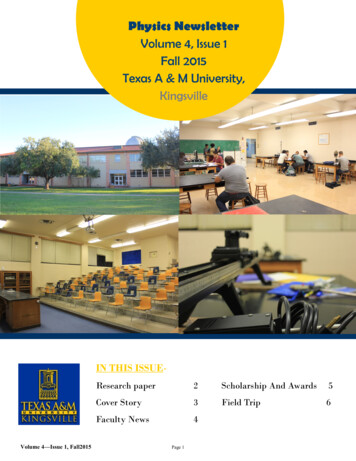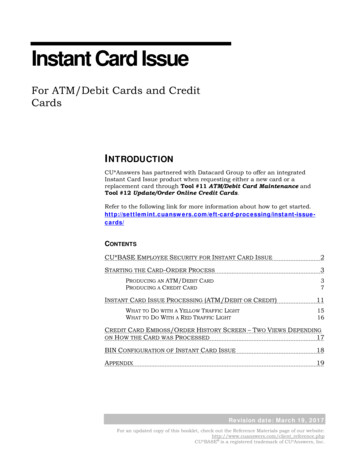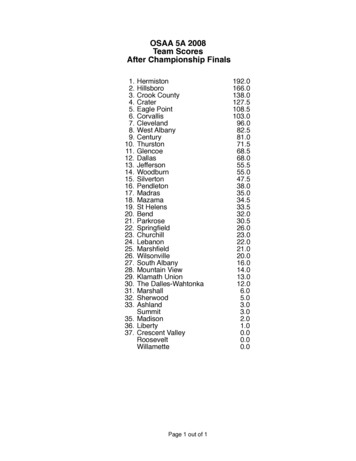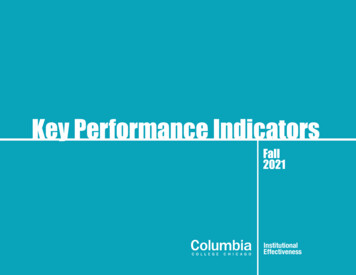
Transcription
Physics NewsletterVolume 4, Issue 1Fall 2015Texas A & M University,KingsvilleIN THIS ISSUE-Volume 4—Issue 1, Fall2015Research paper2Scholarship And Awards5Cover Story3Field Trip6Faculty News4Page 1
Physics Professor Presents Paper at State ConferenceDr. Lionel Hewett, Chair of the Physics/GeosciencesDepartment, presented a paper entitled “Has Dark MatterFinally Been Detected?” at the Spring 2015 Joint Meeting of the Texas Section of the American Physical Society, Texas Section of the American Association of Physics Teachers, and Zone 13 of the Society of Physics Students, held at Lee College, Baytown, TX, March 6,2015. The presentation showed how recent observationsof the X-ray radiation from two distant galaxiesappeared to confirm Dr. Hewett’s theory of TimeSymmetric Cosmology, which predicted that dark mattershould glow dimly in the near X-Ray region of the electromagnetic spectrum. Prior to the detection of this weak3.5 keV X-ray emission line, dark matter had only beendeduced through its gravitational effects upon the bending of light rays and the orbits of stars and galaxies.His current research effort is directed toward answeringsome of the most puzzling questions of modern cosmology such as: What is dark energy, what is dark matter,A large cluster of galaxies with a false color overlay (redand blue clouds) showing the distribution dark matter ascalculated from its gravitational bending of light rays.that this primary creation event was followed almost immediately by an ensemble of secondary creation eventsthat rendered nothing but primordial black holes of various sizes at a temperature near absolute zero. As theseblack holes evaporated through Hawking radiation, theyproduced the high temperature radiation that dominatedour early universe and the excess of matter that is observed today .Dr. Lionel Donnell Hewett’s other research interestshave involved -Experimental data showing the detection of a 3.57 keV X-Rayemission line that appears to come from the dark matter halosurrounding a distant galaxy.1) Einstein’s special and general theories of relativityand their applications to cosmology,and why is there more matter than antimatter in the universe?2) Solar energy, desiccant air condition, and zeroenergy home designs,These questions and others are addressed in Dr. Hewett’sTime-Symmetric model of cosmology which combinesquantum mechanics and gravitation under the most extreme conditions of the creation of the universe. Thismodel assumes that the universe began with a single creation event of zero spatial size and infinite mass-energydensity. The symmetry of time surrounding this eventalong with the principles of quantum mechanics showVolume 4—Issue 1, Fall20153) The physics of towing hang gliders4) Innovative techniques in teaching physics.For more details, you can .edu/hewett/Page 2
My journey of physics By Dr. Lionel HewettIt was the summer of1955, between myjunior and senioryear of high school,that I saw a fascinating, fifteen minute,“short subject” movie at one of the localmotion picture theaters in Fort Worth,Texas. The topic ofthemoviewasDr. Lionel Hewett“Physics at the Massachusetts Institute of Technology (MIT)”. Prior to thismovie, I had never heard of the word “physics”. Butthe movie was so utterly fascinating that I went homeand asked my father, an engineer, if he had ever heardof physics. Naturally, he said, “Yes.” But when I toldhim I was interested in pursuing the subject, he said,“Well, that’s fine, but there is no room for a mediocrephysicists”.You see, prior to that summer I was a C student, but from that time on I became an A student. Mygoal was to attend MIT and become a high schoolphysics teacher. Unfortunately, my one year of academic excellence was inadequate for me to be admitted to MIT, so my father and I looked for a school inTexas that was noted for its physics program. Oursearch showed that the two highest ranking schools inTexas for a physics degree were the University of Texas at Austin (UTA) and the Texas College of Arts andIndustries in Kingsville (A&I). When we visited eachcampus, we found that UTA had enormous classroomswith unavailable faculty (housed in brick buildings)and that A&I had small classrooms with a physicschairman, Dr. Olan E. Kruse, willing to spend his personal time giving us a tour of the campus and departmental facilities (housed in a relocated WWII armybarracks). Needless to say, I chose to attend A&I.Four years later, in 1960, I graduated SumaCum Laude and was offered a 1-year scholarship toMIT or a 3-year scholarship through the Ph. D. to theMissouri School of Mines and Metallurgy at Rolla. Atthat time my goal had changed to teaching physics atthe university level as soon as possible, so I acceptedthe offer at Rolla. Since I was unable to finish my degree in three years, I accepted another 1-year scholarVolume 4—Issue 1, Fall2015ship at Rolla leaving the school with an ABD (All ButDissertation) degree. I came back to Kingsville andbegan my teaching career while finishing my dissertation. Then, at the end of the summer 1965, I graduatedfrom the University of Missouri at Rolla with a Ph.D.degree in Engineering Physics and have been teachingphysics at Texas A &M University, Kingsville eversince.My research interests have varied considerablythroughout my teaching career, from the physics oftowing hang gliders to the practical applications ofSolar Energy. As a result, I have been recognized byDr. Lionel Hewett’s house at Colorado, under constructionboth the United States and the International hang gliding organizations for my contribution to the safety oftowing hang gliders, and I have designed and ambuilding a zero-energy home for retirement in Colorado that is powered exclusively by solar and windenergy.But my greatest love for physics researchthroughout the years has been the pursuit ofknowledge about the fundamental laws of nature andhow the universe came into existence. Therefore, Ihave developed a theory called “Time-Symmetric Cosmology” that assumes the universe began exactly as itappears to begin, namely, as a single point singularityin space-time. This theory predicts how the universebegan; why it is homogeneous, isotropic, and flat(without the assumption of inflation); and why it contains dark energy, dark matter, and the excess of normal baryonic matter that we are able to see today.Page 3
Physics Department Faculty NewsDr. Subbarao Yelisettihas accepted our petrophysics/geophysics tenure track position startingthis Fall, 2015. His research interests involveplate tectonics and geophysical structure at continental margins. Usingvarious types of geophysical data, his researchexaminescrustal-scaleDr. Subbarao Yelisettistructures of the marginsAssistant Professorwhich provide importantcontrol on understanding natural hazards such as earthquakes and tsunami. His research also focuses on the detailed sediment structure in basins and in the accretionarysediment wedge at subduction zones, particularly the frozen methane gas hydrate layer which is found within a fewhundred meters of the seafloor and represents a potentialmassive energy resource and contributor to global climatechange.Dr. Yelisetti’s current and ongoing research projects involve (i) obtaining the detailed crustal structure in the region of 2012 Haida Gwaii earthquake (M7.7), the secondlargest instrumentally recorded earthquake in Canada, (ii)characterizing the sub-seafloor structure associated withpermafrost gas hydrates and fluid migration in the ArcticBeaufort Sea region, and (iii) characterizing the vergencestructure along the seismically active Cascadia subductionzone, using various types of geophysical data. For moreinformation ,visit : http://web.uvic.ca/ subbarao/Dr. Yelisetti is teaching College Physics-1 this Fall whileorganizing his geophysics lectures and planning his research.Prior to joining TAMUK, Dr. Yelisetti was working as apostdoctoral fellow at the Pacific Geoscience Center inSidney, Canada. He obtained his PhD degree in geophysics/seismology in 2014 from University of Victoria, Canada. His thesis focused on examining the detailed geological structure of the northern Cascadia margin. He also obtained MTech degree in mineral exploration in 2008 andMSc in physics in 2006 from University of Hyderabad,India. He obtained BSc degree from Acharya NagarjunaUniversity, India with a specialization in mathematics,physics and chemistry.Volume 4—Issue 1, Fall2015Page 4Dr. Hisham Albataineh joined thephysics program inFall 2014. He received his B.Sc. inPhysics (with minorinmathematics)from Yarmouk University, Jordan. Hereceived his firstM.Sc. in particlephysics from AliDr. Hisham Albatainehgarh Muslim UniverAssistant Professorsity, India. He alsoreceived his M.Sc. and Ph.D. in Experimental Nuclearand Particle Physics from New Mexico State University,USA. Prior to joining Texas A&M University–Kingsville (TAMUK), Dr. Albataineh had been involved in different research groups.He did the first measurement of a transverse single spinasymmetry of open heavy flavor at the PHENIX experiment using polarized proton-proton collisions at centerof-mass energy 200 GeV at Brookhaven National Laboratory. As a member of the sub-atomic group at LosAlamos National Laboratory, he worked on designingand building pixel planes for the silicon vertex detectorfor the PHENIX experiment; this work took place atFermi National Laboratory. For his post-doc,Dr. Albataineh worked for the “Laboratoire de PhysiqueCorpusculaire (University Blaise Pascal, France)” andThomas Jefferson Laboratory on the second generationof the Deep Virtual Compton Scattering experiment. Dr.Albataineh joined TAMUK in June 2011 as director forresearch and graduate studies at the Frank H Dotterweich College of Engineering where he started teachingnuclear/mechanical engineering classes. Currently heholds a joint position between the Physics Departmentand the Mechanical Engineering Department.
Physics Department FacultyNewsMrs. CherrieNelson joinedthe Physics ProgramatTAMUK in thefallof2015. She received her Master's Degree inPhysics Education from theWestern Governors UniversityMrs. Cherrie Nelsonin 2014.ShecompletedherLecturerbachelor’s fromGeneral Science Grandview University .Prior to TAMUK, she taught physics in high school atAransas Pass, Texas. She holds a Master TeacherLicense for the state of Iowa, where the requirementfor teaching requires a 3.0 in each subject matter.Her interests are teaching science. She researches andexplores new methods for improving test scores andhelping students achieve their goals.Her hobbies include star gazing.On Oct 20, 2015 Driscoll Middle School in CorpusChristi held a Science Night for family and students attheir school. Texas A & M was invited to join in thiscelebration and show off the stars and planets with atelescope and star globes.Our freshmen who joined thenew physics programWe have three new physics majors who are thefirst freshmen to enroll inour new Texas PhysicsConsortium (TPC) program .Thomas Cruz came tous from Corpus Christi,Edson Estrada camefrom Laredo, and Angel Gonzalez cameThomas Cruzfrom Houston. We areoverjoyed to have them with us and hope everyone willjoin us in welcoming them to our campus.Physics Scholarship AwardedThe following physics majors were awarded scholarshipsfor the Fall 2015 semester by the Department of Physicsand Geosciences:Angel Gonzalez r eceived the 500 Alumni PhysicsScholarship and the 500“Olan Kruse Scholarship”.The telescope was another huge hit; as students waited behind their teachers to see the planets Jupiter andMoon in the night sky. Late that night Mrs Cherrieleft the school with a promise to return soon for another sky viewing.Students and parents were informed that different patterns arriving in the night sky is a way to determinethe time of year. Most were aware of the stars crossing the sky, but did not realize that the stars follow aset and predictable pattern.Volume 4—Issue 1, Fall2015Edson EstradaEdson Estrada r eceived the 500 “Walter Sells Scholarship” and the 500 “AlumniPhysics Scholarship”. Thisscholarship fund is offeredeach semester during the regular school year for a studentmajoring in Physics who hascompleted less than 60 semester credit hours at the timeof the award.We are proud of these students and are looking forward toseeing their continued academic achievements in the future.Page 5
Sps Students Attend The Spring 2015 Joint Physics ConferenceThe Texas A&M University – Kingsville’s‘Society of Physics Students’ chapter recently traveled to Baylor University for the Fall2015 Joint Meeting for the American Physical Society (APS), American Association ofPhysics Teachers (AAPT), and Zone 13 Society of Physics Students (SPS). SPS clubmembers were able to attend a variety ofpresentations concerning topics from cancercell location, to single photon transportthrough an atomic chain. One particularlyinteresting presentation, given by Dr. Donald Olson of Texas State University, coveredthe Tacoma Narrows Bridge which failed 75years ago. Tracker software and detailedvideo analysis suggested that resonance wasnot the cause of failure as, has been widelyaccepted since the accident. Dr. Olson suggests that it was the twisting of the bridgewhich ultimately caused its failure. Anothervery interesting presentation was given byTAMUK’s own Erik Harwell coveringComplex Matter Space and introduced Hilbert Space. Harwell’s presentation endedwith a concept suggesting travel faster thanthe speed of light being theoretically possible. Students also attend several hands-onworkshops, one of which explained how rustother corrosion is removed from largerframes, such as the Eifel Tower. The SPSmembers also had tour of the college duringdown time. Though there wasn’t a surplus of‘down time,’ there was enough for somestudents to tour the campus. From groundbreaking research presentations, to relaxingwith the two bears held in something similarto a zoo-enclosure where the university mascots are kept, this TAMUK senior highlyrecommends any interested students to jointhe SPS club .Stating from left, Jennifer Benavides,Frank Ashley III, Gabriel Barrera,Kevin Valenzuela, Andres Camillo,Kezia Hilay, John Thomas, CassandraCarrizales, Daniel Rodriguez, DavidCastillo, Steven Thomas, Andy Umoh,Christian Albear.- By John ThomasVolume 4—Issue 1, Fall2015Page 6
The following physics majors were awarded scholarships for the Fall 2015 semester by the Department of Physics and Geosciences: Angel Gonzalez received the 500 Alumni Physics Scholarship and the 500 "Olan Kruse Scholarship". Edson Estrada received the 500 "Walter Sells Scholar- ship" and the 500 "Alumni Physics Scholarship".











